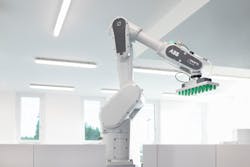ABB Brings Collaborative Capabilities to Industrial Robots
As much attention as collaborative robots (cobots) draw, manufacturers should realize that it’s no longer just cobots that are capable of collaboratively working alongside humans. Collaborative capabilities are increasingly being applied to industrial robots, as ABB showcased with its Swifti CRB 1300 robot at Automate 2023.
With a payload capacity of 11 kg, speeds up to 6.2 m/s, reach from 0.9 to 1.4 m and protection against dust and moisture (up to IP67), the Swifti CRB 1300 is up to five times more precise than any cobot in its class, according to ABB. The features of the Swifti CRB 1300 were developed for use in tasks requiring accuracy and repeatability, such as palletizing, pick-and-place and screwdriving applications.
Humans can work near the Swifti CRB 1300 due to its use of a safety laser scanner integrated with ABB’s SafeMove collaborative safety software. ABB said the combination of these technologies enables “safe collaboration to be achieved without the space and cost associated with installing protective fencing or other physical barriers."
When the laser scanner on the Swifti CRB 1300 detects a worker within its operating area, the SafeMove software slows the robot as the worker approaches and stops it completely once the worker gets too close. As the worker moves away, the Swifti CRB 1300 slowly resumes its operation, only returning to full speed once the working area is completely clear.
A built-in status light on the Swifti CRB 1300 serves as an additional, visual indication of the cobot’s status when a worker is within the workspace area.
Demonstrating the Swifti CRB 1300’s collaborative capabilities at Automate 2023, Mark Ruth, chief engineer at ABB, showcased how the robot combines “the high speeds, high acceleration and increased payloads typically seen on industrial robots with collaborative features” such as the built-in status light. “When the light is green, the robot is running at its full program speed,” explained Ruth. “When you approach the robot, the light will turn yellow, meaning that it's running at a safety rated reduced speed. Then as you get even closer the light will turn red and that means it's in safety-rated standstill. At this point, an operator could come in and change out bins or refeed the hopper. When they clear the area, the robot will resume its tasks without any kind of intervention.”
ABB also noted that the Swifti CRB 1300 can be programmed in two ways—by guiding it through a process (lead-through programming) or with ABB’s new Wizard Easy Programming software, which uses graphical blocks to program multiple commands.
In the video below, Mark Ruth of ABB demonstrates the Swifti CRB 1300's collaborative capabilities.

